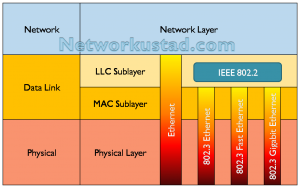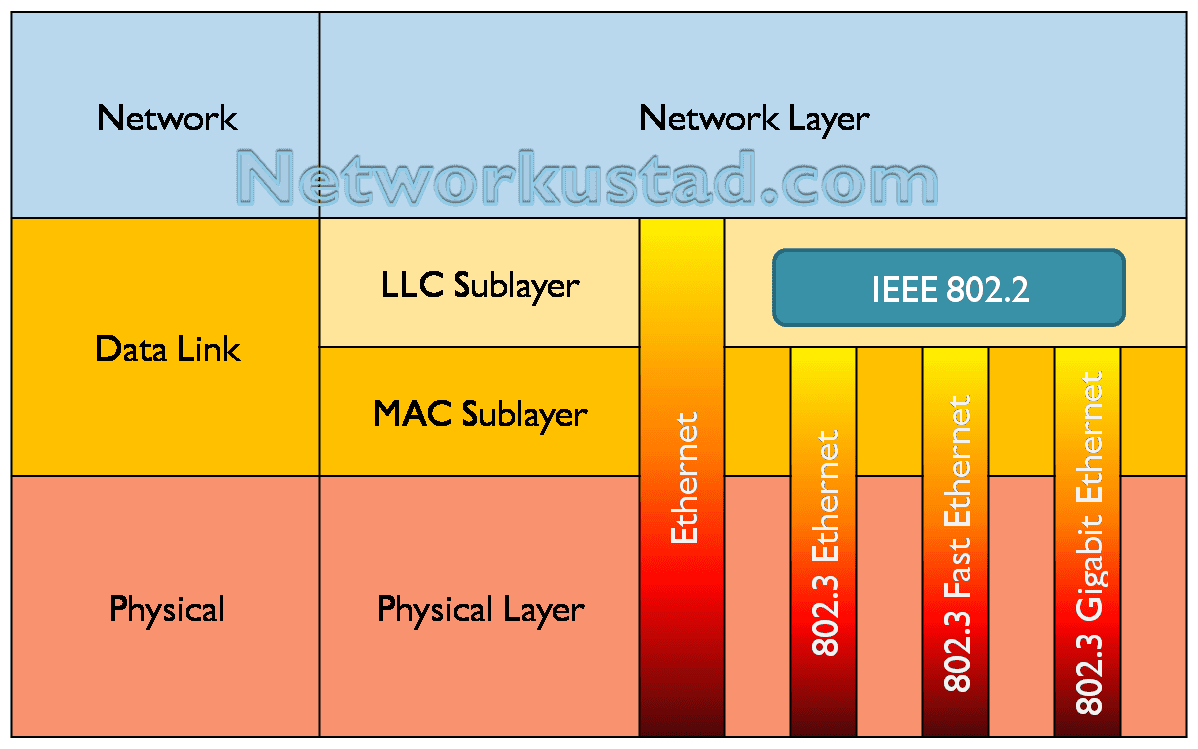2 Sublayers – LLC and MAC Important Functions
The data link layer is split into logical sublayers: the upper sublayer, the LLC sublayer, communicates with the network layer, and the lower sublayer, the MAC sublayer, communicates with the physical layer below. This article presents a brief function of both sublayers of the data link layer. The Figure below illustrates the structure of LLC and MAC Sublayers۔

LLC Sublayer Overview and Function
The upper sublayer of the data link layer is known as the LLC sublayer. It communicates with the upper layers of the OSI model. It gets the network protocol data, which is usually an IPv4 packet. The LLC sublayer also adds control information to help deliver the packet to the destination. The LLC sublayer communicates with the upper layers of the application and transitions the packet to the lower layers for delivery.
LLC is implemented in software and is independent of the hardware. The driver software of the computer NIC can be considered LLC. The driver is a software program and instruction that interacts directly with the computer NIC and other hardware. Driver software also enables communication between the network device, computer, and operating system, as well as with other network computers and network devices.
Multiplexing/De-Multiplexing
As mentioned earlier, LLC communicates with the uppers, i.e., the network layer. When the data link layer receives a frame from the physical layer, the LLC looks at the Layer 3 Protocol type and hands over the datagram to the correct Layer 3 protocol. It is called the de-multiplexing process.
When Layer 3 sends a packet, LLC takes it from different Layer 3 protocols, such as IP, IPX, ARP, etc., and forwards it to the MAC layer after adding the Layer 3 protocol type in the LLC header portion of the frame multiplexing. This process is called the multiplexing process.
LLC optionally present reliable frame forwarding. With the help of LLC, the sending node numbers for each frame during transmission are called sequence numbers; on the other hand, the receiving node acknowledges each received frame using the acknowledgement number.
The sending node retransmits lost frames if the frame is lost during transmission. The LLC also provides flow control optionally by allowing the receivers to control the sender’s speed through control frames known as Receive Delay and Receive Not Delay. LLC provides the following types of services.
Unacknowledged Connectionless Service
Connectionless service is also known as the best effort service, e.g. IP datagram service, without prior connection establishment between source and destination and without acknowledgement. The data is sent to the peer directly without any connection establishment in the connectionless service. The connectionless service is also unreliable because reliability, flow control and error control are provided at the transport layer. It is provided flow control optionally.
Connectionless Acknowledged Service
In this type of service, data is directly sent between Layer2 peers without any prior logical link establishment. But the difference with the previous service is that this service marks each frame with its sequence numbers, and the peer acknowledges each frame received using an Acknowledgment number field. This service mode is used where data reliability is needed.
The data sender can track lost or damaged frames and retransmit them to achieve reliability. The wireless links use connectionless acknowledged service, where the quality of the link is not good.
Connection-Oriented Service
Before sending data, a logical connection is established between peers in this type of service. Before starting data transfer, the service exchanges the control frames, known as Supervisory Frames, to establish a logical connection. Actual data transfer starts after the connection establishment phase is over. Two types are used in connection-oriented service: one is without acknowledgement, and another is with acknowledgement.
Connection-oriented service Without Acknowledgment
In this type of service, a logical link is established before the actual data transfer starts but without any concept of frames being numbered and acknowledged through Sequence number and acknowledgement number fields. Examples of this service are HDLC, PPP, and LAPB.
Connection-oriented service with Acknowledgment
In this type of service, a logical link is established before actual data transfer starts, but with the concept of frames being numbered and acknowledged through Sequence number and acknowledgement number fields. The LLC sublayer also provides reliability and flow control services through sequence number, acknowledgement number and retransmission of lost frames. The sliding window mechanism provides Flow control. Most of the Internet use this type of service because the Internet uses TCP,
The function of the MAC sublayer
MAC is the lower sublayer of the data link layer. It is listed in the IEEE 802.3 standards. The figure above lists common IEEE Ethernet standards. It also shows how the data link layer is divided into the LLC and MAC sublayers. The LLC sublayer communicates with the network layer, while the MAC sublayer allows various network access technologies.
For instance, the MAC sublayer communicates with Ethernet LAN technology to send and receive frames over copper or fibre-optic cable. It also communicates with wireless technologies such as Wi-Fi and Bluetooth to send and receive frames wirelessly.
The Media Access Control (MAC) layer is between the LLC sublayer and physical layers. The MAC sublayer has the following key tasks:
- Data encapsulation
- Media access control
Data encapsulation
The data encapsulation process includes frame assembly from the transmission node and disassembly on the receiving node. The MAC layer adds a header and trailer to the network layer PDU to form the frame. Data encapsulation provides three key functions:
- Data Framing- The framing process provides a sequence of one or more characters to recognize a group of bits that make up a frame. These sequence bits provide synchronization between the transmitting and receiving nodes.
- Addressing -The data link layer is the lowest in the OSI model for addressing. The Data Link Layer receives Layer 3 PDU. The encapsulation process in the data link layer provides the data link layer address as well as labelling information with a particular destination location. Every device on a network has a unique number, generally called a physical address or MAC address, used by the data link layer protocol to ensure that data intended for a specific machine gets to it properly.
- Error detection –Each frame’s data link contains a trailer that detects any errors in transmissions.
Media Access Control
The Media Access Control sub-layer’s second responsibility is to control access to the media. This sub-layer is also responsible for placing frames on the media and removing frames from the media. The MAC sub-layer communicates directly with the physical layer.
[qsm quiz=4]

